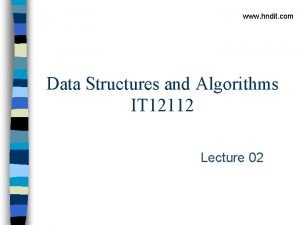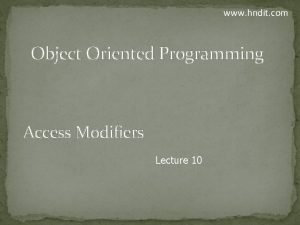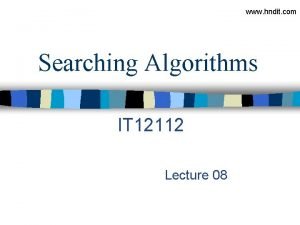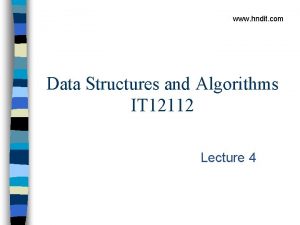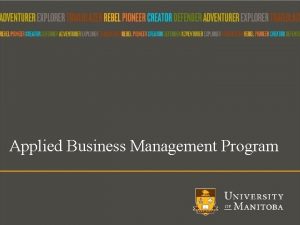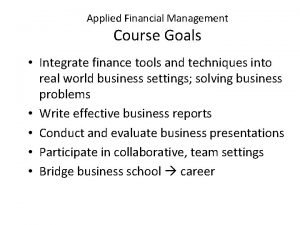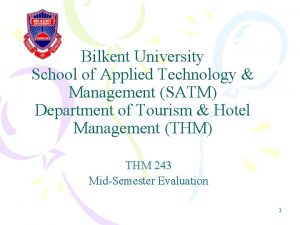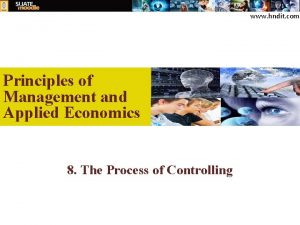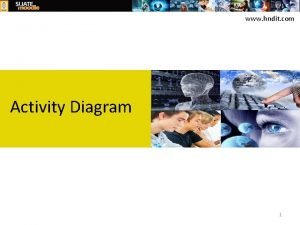www hndit com Principles of Management and Applied



























- Slides: 27

www. hndit. com Principles of Management and Applied Economics 3. Evolution of Management Thought –Part I

www. hndit. com Evolution of Management Thought

www. hndit. com Progressive Stages of the Evolution of Management § Development of informal body of management thought § Main forces that preceded the development of formal body of management thought § Formal body of management thought

www. hndit. com Development of Informal Body of Management Thought § The Great Pyramids in Egypt in 2700 BC - 1700 BC § The Roman Empire (founding in 27 BC by the Roman Emperor Augustus until the fall in the West in 467 AD and the transition in the East in 610 AD) § The Great Wall of China build between 220 BC to 206 BC § The wondrous work of Sri Lankan Kings

www. hndit. com Ancient Contributors to the Management Discipline and examples Socrates Great Pyramids in Egypt Plato Great Wall of China Julius Caesar Sigiriya in Sri Lanka

www. hndit. com Forces that Preceded the Development of Formal Management Thought in the West § The Protestant Work Ethic Martin Luther and John Calvin (16 th Century) § Capitalism and Division of Labour Adam Smith (Early 17 th Century) § The Industrial Revolution James Watt and Guttanberg (Late 17 th Century) § The Productivity Problem Gradual reduction in organisational efficiency and effectiveness over the years

www. hndit. com Evolution of Management Thought 1800 1910 1920 1930 1940 1950 1960 1970 1980 1990 2000 2010 Now Scientific Management Theory, Administrative Management Theory and Bureaucratic Management Theory The Behavioral School Management Science Approach Systems Approach Contingency Approach Other Modern Approaches 7

Development of Formal Body ofwww. hndit. com Management Thought § § § § Classical approach Behavioural approach Management Science approach System approach Contingency approach Japanese approach Excellent approach

www. hndit. com Classical Approach to Management § Scientific Management Theory § Administrative Management Theory § Bureaucratic Management Theory 1800 1910 1920 1930 1940 1950 1960 1970 1980 1990 2000 2010 Scientific Management Theory, Administrative Management Theory and Bureaucratic Management Theory

Classical Approach www. hndit. com Scientific Management Theory This theory focuses on the improvement of operational efficiencies through the systematic and scientific study of work methods, tools, and performance standards. Key Contributors to the Scientific Management F. W. Taylor (1856 -1915) Frank Gilbreth Lillian Gilbreth Henry Gantt (1868 -1924) (1878 -1972) (1861 -1919)

www. hndit. com Scientific Management Theory F. W. Taylor - US Engineer/ Father of Scientific Management is considered as a science of working towards higher productivity through higher work efficiency. It believed that there is always a best standardized method of work for which the workers can be trained scientifically. 11

www. hndit. com Identified Reasons for Labour Inefficiency and Low Productivity in Organizations Existed in late 19 th and Early 20 th Century § Soldiering § Rule of Thumb § Lack of concern for working conditions § Non-availability of effective incentive methods 12

Scientific Management Theory www. hndit. com The Assumptions of Scientific Management • Economic rational man • One best method of work • Workers have the potential of doing any work prescribed by the science

Scientific Management Theory www. hndit. com Principles of Scientific Management § Develop a standard method for performing each job. § The scientific selection of workers. § The scientific education and development (training) of the worker. § Intimate, friendly cooperation between management and labour. § Tie the work performance of employees with the economic rewards.

Scientific Management Theory. The Phases of Scientific Management www. hndit. com Phase 1: The work situation A task to be performed, a pool of workers, and management. Management Total task Pool of workers (Griffin, 2007)

www. hndit. com Scientific Management Theory. The Phases of Scientific Management Phase 2: Task analysis Management scientifically studies, specializes, and standardizes task elements. Key: M= Management W= Worker T= Task Elements M T 1 T 2 T 3 T 4 T 5 W 1 W 2 W 3 W 4 (Griffin, 2007) W 5

www. hndit. com Scientific Management Theory. The Phases of Scientific Management Phase 3: Matching tasks with workers Management selects, trains and assigns workers to task elements. Key: M= Management W= Worker T= Task Elements M W 1 W 2 W 3 W 4 W 5 T 1 T 2 T 3 T 4 (Griffin, 2007)

www. hndit. com Scientific Management Theory. The Phases of Scientific Management Phase 4: Continued management Management supervises and maintains planning responsibilities. M Key: M= Management W= Worker T= Task Elements W 1 W 2 W 3 W 4 W 5 T 1 T 2 T 3 T 4 (Griffin, 2007)

Classical Approach. Administrative Management www. hndit. com Administrative Management theory focuses on the improvement of productivity of the entire organization. Key Contributor to the Administrative Management Theory Henri Fayol (1841 -1925)

www. hndit. com Administrative Theory Fayol’s Three Aspects of Management § The Activities of an Organization § The Functions of Management § The Principles of Management

www. hndit. com The Activities of an Organization § Technical activities (Production, Manufacturing) § Commercial activities (Buying and selling) § Financial activities (Search for and best use of capital) § Security activities (Safeguarding property and people) § Accounting activities (Recording financial information) § Managerial activities (Planning, organizing, commanding , coordinating and controlling)

www. hndit. com The Functions of Management § Plan § Organize § Command § Co-ordinate § Control

www. hndit. com Fayol’s 14 Principles of Management 1. Division of Labour 8. Authority 2. Discipline 9. Unity of Command 3. Unity of Direction 10. Subordination of Individual Interest to the Common Goal 4. Remuneration 11. Centralization 5. The Hierarchy 12. Order 6. Equity 13. Stability of Staff 7. Initiative 14. Esprit de Corps

Classical Approach Bureaucratic Management Theory www. hndit. com This theory stressed the need for a strictly defined hierarchy governed by clearly defined rules and regulations and line of authority in an organization. Key Contributor to the Bureaucratic Management Theory Max Weber (1864 -1920)

Bureaucratic Management Theory www. hndit. com Characteristics of a Bureaucratic Organization § Clearly defined objectives § A set of impersonal and logical rules and routine § Division of labour § Positions arranged in a hierarchy § Clearly defined authority § Selection based on technical qualifications § Strict adherence to a clear chain of command

www. hndit. com Comparison of Theories in Classical Approach Taylor Fayol Weber Focus Individual work efficiency (Micro) Organizational efficiency (Macro) Bureaucratic rationality (Macro) Orientation Industrial engineering Managerial Sociological Methodology Scientific Methods Administrative Principles Bureaucratic principles

www. hndit. com General Criticisms on Classical Approach § Too much emphasis on principles, structures and methods (Technical Factors) in order to improve productivity. § Social and psychological needs of the workers were not recognised adequately. § Worker was considered as a slave or a machine. § Too much emphasis on capital as the main input factor. § Not recognised the informal behaviour of humans. 27
 Bài thơ mẹ đi làm từ sáng sớm
Bài thơ mẹ đi làm từ sáng sớm Cơm
Cơm Hndit syllabus
Hndit syllabus Hndit syllabus
Hndit syllabus Hndir.com
Hndir.com Hndit.com
Hndit.com Hndit
Hndit Hndit.com
Hndit.com Hndit
Hndit Hndit
Hndit Hndit
Hndit Hndit application 2020
Hndit application 2020 Hndit
Hndit Rhythm stone
Rhythm stone Principles of applied engineering
Principles of applied engineering Applied principles of horticultural science
Applied principles of horticultural science Applied software project management
Applied software project management Applied software project management
Applied software project management Applied psychology in human resource management
Applied psychology in human resource management Applied software project management
Applied software project management Applied psychology in human resource management
Applied psychology in human resource management Applied psychology in human resource management
Applied psychology in human resource management Business management courses winnipeg
Business management courses winnipeg Cisi chartered wealth manager
Cisi chartered wealth manager Applied psychology in human resource management
Applied psychology in human resource management Applied software project management
Applied software project management Applied financial management
Applied financial management Applied technology management
Applied technology management





